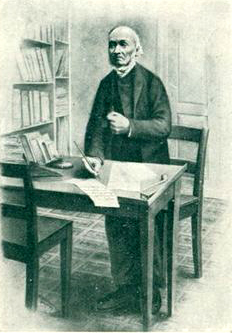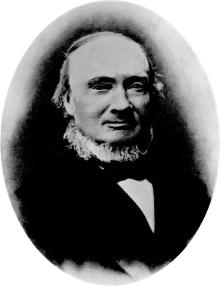Top Qs
Timeline
Chat
Perspective
Ivar Aasen
Norwegian philologist and lexicographer (1813–1896) From Wikipedia, the free encyclopedia
Remove ads
Ivar Andreas Aasen (Norwegian pronunciation: [ˈîːvɑr ˈòːsn̩]; 5 August 1813[1] – 23 September 1896) was a Norwegian philologist, lexicographer, playwright, and poet.[2] He is best known for having assembled one of the two official written versions of the Norwegian language, Nynorsk, from various dialects.[3]
This article may require copy editing for style and tone of the EB1911 excerpts. (June 2025) |
Remove ads
Background
Iver Andreas Aasen was born in 1813 in Åsen (at the time also spelled Aasen), in the parish of Ørsten (now Ørsta Municipality), in the district of Sunnmøre, on the west coast of Norway. His father Ivar Jonsson, a peasant with a small farm, died in 1826. Young Iver was brought up doing farmwork, but he assiduously cultivated all his leisure in reading.[4] An early interest of his was botany.[5] When he was eighteen, he opened an elementary school in his native parish. In 1833, he entered the household of Hans Conrad Thoresen, the husband of the eminent writer Magdalene Thoresen, in the parish of Herø (now Herøy Municipality), where he picked up the elements of Latin. Aasen gradually mastered several languages, and began the scientific study of their structure.[4] Ivar single-handedly created a new language for Norway, which later became its "literary" language.[6]
Remove ads
Career
Summarize
Perspective
When Aasen travelled to Bergen in 1841, he met bishop Jacob Neumann, who was very impressed with his work, and had excerpts of it published in Bergens Stiftstidende ("Bergen Diocese Newspaper"). His contacts with Bishop Neumann became Aasen's entrance ticket to the Royal Norwegian Society of Sciences and Letters in Trondheim, and generous financial support (an annual grant of 120-200 speciedaler), which made the extensive travel possible to study the Norwegian vernacular. It is said to have been the rector of Trondheim, Fredrik M. Bugge, who came across Neumann's articles while travelling in Bergen and persuaded the scientific society to grant the funding to Aasen.[7]

Therefore, quite early in his career, in 1842, Aasen had begun to receive a grant to enable him to give his entire attention to his philological investigations;[8] he had ceased doing any farmwork by 1846.[4] Aasen's first monograph in 1843 was a small collection of folk songs in the dialect of his native district, Sunnmøre, which attracted general attention.[4] His Grammar of the Norwegian Dialects (Danish: Det Norske Folkesprogs Grammatik, 1848) was the result of long studies, and of journeys taken to every part of the country. Aasen's well-known Dictionary of the Norwegian Dialects (Danish: Ordbog over det Norske Folkesprog) appeared in its original form in 1850, which became the basis of his construction of a popular language or definite folke-maal (lit. 'people's language') for Norway.[4]
By 1853, he had created the norm for utilizing his new language, which he called Landsmaal, meaning "country language".[6] With certain modifications, the most important of which were introduced later by Aasen himself,[4] but also through a latter policy aiming to merge this Norwegian language with Dano-Norwegian, this language has become Nynorsk (lit. 'New Norwegian') (see Legacy § Nynorsk).
Aasen composed poems and plays in the composite dialect to show how it should be used. One of these dramas, The Heir (1855), was frequently acted, and may be considered as the pioneer of dialectal literature of the second half of the 19th century, from Vinje to Garborg.[8] In 1856, he published Norske Ordsprog, a treatise on Norwegian proverbs. Aasen continuously enlarged and improved his grammars and his dictionary. He lived very quietly in lodgings in Oslo (then Christiania), surrounded by his books and shrinking from publicity, but his name grew into wide political favour as his ideas about the language of the peasants became more and more the watch-word of the popular party.[8] In 1864, he published his definitive grammar of Nynorsk and in 1873 he published the definitive dictionary.[9]
The Storting (the Norwegian parliament), conscious of the national importance of his work, treated Aasen in this respect with more and more financial generosity as he advanced in years.[8] He continued his investigations to the last, but it may be said that, after the 1873 edition of his Dictionary (with a new title:[5] Danish: Norsk Ordbog), he added but little to his stores.[8]
He died in Christiania on 23 September 1896, and was buried with public honours.[8][10]
Remove ads
Legacy
Summarize
Perspective

Nynorsk
The language standardised by Aasen, Landsmaal would later be renamed to Nynorsk (lit. 'New/Modern Norwegian'), and emerge as the second of Norway's two official languages (the other being Bokmål, the Dano-Norwegian descendant of the Danish language used in Norway in Aasen's time). An unofficial variety of Norwegian closer to Aasen's language is still found in Høgnorsk (lit. 'High Norwegian'). As of the early 2000s, some scholars considered Nynorsk on equal footing with Bokmål, as Bokmål tended to be used more in radio and television and most newspapers, whereas Nynorsk was used equally in government work,[3] as well as approximately 17% of schools.[11] Although it was not as common as its brother language, some scholars argued it needed to be looked upon as a viable language, as a large minority of Norwegians used it as their primary language, including many scholars and authors.[11] Nynorsk is both a written and spoken language.[12]
The Ivar Aasen Centre
Ivar Aasen-tunet, an institution devoted to the Nynorsk language, opened in June 2000. The building in Ørsta was designed by Norwegian architect Sverre Fehn. Their web page includes most of Aasens' texts, numerous other examples of Nynorsk literature (in Nettbiblioteket, the Internet Library), and some articles, including some in English, about language history in Norway.
2013 Language year
Språkåret 2013 (The Language Year 2013) celebrated Ivar Aasen's 200 year anniversary,[13] as well as the 100 year anniversary of Det Norske Teateret. The year's main focus was to celebrate linguistic diversity in Norway.[14] In a poll released in connection with the celebration, 56% of Norwegians said they held positive views of Aasen, while 7% held negative views.[15] On Aasen's 200 anniversary, 5 August 2013, Bergens Tidende, which is normally published mainly in Bokmål, published an edition fully in Nynorsk in memory of Aasen.[16]
Nynorsk day and Nynorsk Week
Nynorskdagen (Nynorsk day) is set to the 12th of May. It commemorates the day of Jamstillingsvedtaket, the law making Landsmål/Nynorsk an official language of Norway beside Danish (later Bokmål). Noregs Mållag encourages people and organisations that don't usually use the language to write Nynorsk on this day. Companies have often Made Nynorsk versions apps coinside with this day. Notably Vipps and Ruter have released Nynorsk language support for there mobile apps on the 12th of May. The Nynorsk day has been expandend into a Nynorsk week, from the 6th to the 12th of May.[17][18]
Remove ads
Bibliography
Aasen published a wide range of material, some of it released posthumously.
Remove ads
Footnotes
References
External links
Wikiwand - on
Seamless Wikipedia browsing. On steroids.
Remove ads


